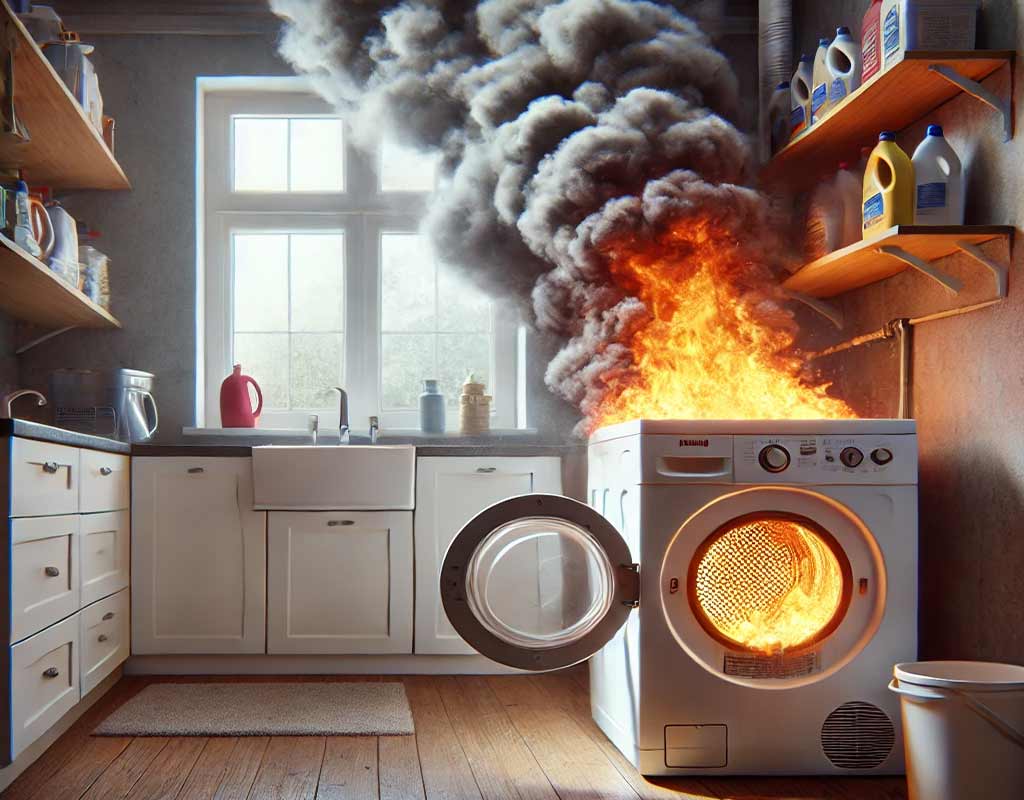How Common Are Dryer Vent Fires?
Dryer vent fires are more prevalent than many realize. According to the U.S. Fire Administration (USFA), approximately 15,000 dryer fires are reported annually, resulting in $35 million in property loss.
These fires typically peak in the fall and winter months, with January being the most common month for such incidents.
Why Do Dryer Vent Fires Occur?
The primary cause of dryer fires is failure to clean the dryer vent, accounting for nearly 34% of all dryer-related fires. Other contributing factors include:
Lint Buildup: Lint, a highly flammable material, can accumulate in the dryer vent, drum, or lint trap, creating a fire hazard when exposed to high heat.
Restricted Airflow: Blockages in the dryer vent restrict airflow, causing the dryer to overheat. This heat can ignite accumulated lint or other combustible materials.
Mechanical or Electrical Failures: Faulty wiring, damaged components, or malfunctioning thermostats can lead to overheating and fires

Improper Venting: Vents made from flammable materials, like plastic or foil, or those with excessive bends and kinks, increase the risk of fire.
Overloading the Dryer: Overloading the dryer forces it to work harder, generating excessive heat that can ignite lint or clothing fibers.
Drying Flammable Items: Items stained with grease, oil, or flammable liquids can combust during the drying process.
How to Prevent Dryer Vent Fires
Preventing dryer vent fires involves routine maintenance and mindful practices. Here are steps you can take to reduce the risk:
Clean the Lint Trap Regularly: Remove lint from the trap before and after each load of laundry. Ensure no lint is stuck around the edges of the trap.
Inspect and Clean Dryer Vents: Have your dryer vent professionally cleaned at least once a year to remove lint buildup and ensure proper airflow. If you notice your clothes taking longer to dry, this may indicate a clogged vent.
Use Rigid or Metal Venting: Replace flexible plastic or foil vents with rigid or semi-rigid metal ductwork, which is more resistant to heat and less prone to blockages.
Don’t Overload the Dryer: Follow the manufacturer’s guidelines for load size to avoid overworking the machine.
Avoid Drying Hazardous Items: Do not dry items that have been exposed to chemicals, oils, or flammable substances. If you must, wash them thoroughly first.
Check for Proper Installation: Ensure the dryer vent system is installed correctly, with a straight path to the exterior and minimal bends to reduce airflow restriction.
Regular Maintenance: Have the dryer professionally inspected periodically to check for mechanical or electrical issues.
Install Smoke Alarms: Place smoke alarms near the laundry area to detect any fire quickly.
By taking these precautions, homeowners can significantly reduce the risk of dryer vent fires. Proper maintenance and awareness not only protect your property but also ensure the safety of your family.
Your Dryer Can Start A Fire. Have your vents inspected
Your health matters and putting off a simple home inspection just to make sure your health is not negatively being affected by undesirable air is irresponsible.
Air that may have been compromised years earlier and gone unnoticed only to escalate into an unhealthy scenario.
Over 15,000 dryer vent fires are reported every year and just a simple annual cleaning can prevent such a disaster.
There are several steps we take
We check all your air duct grill’s or face plates. This is where your hot and cold air blows out. Usually if your ducts need to be cleaned we will see dust build up around your individual grill louvers and in some cases even blockage. We also remove the grill and utilize our snake crawling swipe detector that goes deep inside your ducts. These tests will help us evaluate whether your vents and ducts need attention.
We have special camera equipment and tools you don’t
We are experienced at this stuff and have the right equipment to properly inspect your ducts or air vents. Cameras, long spinning cleaners and air testing swabs are just some of the tools we’ll bring when inspecting your dwelling. Call us today and gain peace of mind that your vents and ducts can’t hurt your breathing or worse, burn down your home.
